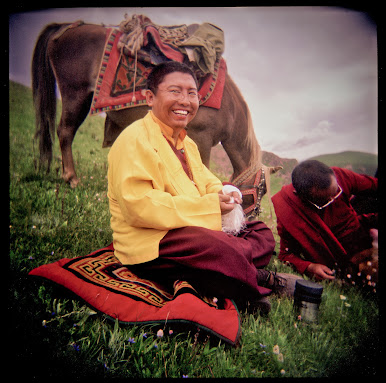Bringing the lung down
There is a particular teaching Tsoknyi Rinpoche has given on a number of occasions that I would like to share. I have found this practice especially helpful during difficult times. I have received these teachings both privately and in public. In a Renunciation Retreat given in Crestone, Colorado, Rinpoche described some of the signs that indicate when your lung (prana or wind) is out of balance and the moving upward prana is giving us trouble. A general sign is a busy feeling in the body, a feeling that we want to move, feeling restless and agitated. Underlying that feeling is a sense of fear, but you don’t know why. You might be afraid of light or have difficulty being fully present. Rinpoche condensed in a few words the sense of a healthily balanced prana as feeling clean, open, and having guts and an unbalanced state as cloudy, tight and fearful. Other signs of imbalance might include a dry tongue and lips, pain in different parts of the body, an inability to express yourself well and not being able to just sit down and relax. In general, you might be feeling depressed and lacking in energy or inspiration.
Rinpoche says:
"The first thing we need to do is locate lung’s buzz with our conceptual mind. Make this connection in a relaxed manner through the practice of long, slow breathing. Keep mindfulness on the movement of the breath as it locates lung and makes a connection with it. Then, in an equally relaxed manner, begin a mental scan of how lung feels. When you have a clear picture of this, begin to gently bring lung down with the help of the breath, slowly breathing in and out. This soft breathing practice is called “jam lung” and is a traditional practice for working with the subtle body. It acts like a French press coffee maker, using the movement of breath to gently bring the energy of lung down through the body to below the navel.
Jam lung is very simple to do. Relax and take long in-breaths, encouraging the body to rest loosely. Then the conceptual mind can examine the body to see where lung’s speediness is active. We find the points where there is tension and tightness, indicating the presence of speediness. As we breathe in the press goes down, connecting with lung wherever we find it. The moment the mind locates the speedy buzz it’s already making a relationship with it. When we’re ready for the next breath we exhale and begin again. Eventually, we’re able to bring lung smoothly down below the navel. Upward-moving lung cannot find its own way home if mind doesn’t escort it down. By doing jam lung correctly over and over, restless lung can become normal as it enters the central channel and returns to its home below the navel. It’s very important to establish this collaboration between conceptual conceptual mind and the speedy energy of lung; otherwise we might do jam lung practice with our speedy minds and remain out of touch with lung. It may take a while to get it all together, so have patience and persistence, giving plenty of time to jam lung during practice. If we do jam lung slowly and mindfully as part of our daily practice, lung will definitely learn to stay down. If we train like this for one, two or more months, we’ll naturally know when lung is down or not and when it starts to move up. When we feel lung is down, all the big muscles in the body loosen up and we feel quite light. With lung staying in its home, even when we’re doing a lot, we won’t suffer from buzzy, speedy lung. In post meditation, during which we maintain the mood of meditation, it’s good to keep about 10% of the energy below the navel with slight muscle pressure above and below lung’s home. This helps gently keep the energy down and enables us to function well in the world. With 10% of the energy held below the navel we can breathe normally, our minds can function normally, and we can get on with whatever we’re doing."
This practice of bringing the lung down and holding the breath below the navel is not much different from vase breathing. Even though it is a simple practice it has profound effects. I believe it is a good precursor for the more complex practice of tummo.11 In my own experience, I find that after bringing the lung down and holding the breath below the navel for twenty to fifty times I feel more grounded and spacious. It is much easier to rest in rigpa or at least formless meditation after performing this practice.


Comments
Post a Comment